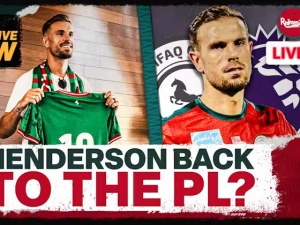
A Five-Star Player Recalled Back Career Full of Surprises.
In professional sports, some stories are nothing short of captivating. The journey of a player who ascends to stardom only to return to their roots adds a layer of intrigue to an already unpredictable career. One of the most dramatic twists in an athlete’s career happens when a five-star player, often a former star or once-promising prospect, is recalled back from their former team after years away. This journey, filled with lessons, growth, and unexpected turns, captures the attention of fans and analysts alike. But what does it mean for both the player and the team involved when this unexpected reunion occurs?
The Rise to Stardom: A Player’s Early Years
Before the player becomes a household name, their journey begins much like any other. For many, the road to professional sports is paved with sacrifice, dedication, and an unyielding passion for their craft. A five-star player is one that’s recognized from the outset for their exceptional talent, whether they’re drafted into the league, signed from another team, or scouted early on. This athlete often enjoys immediate success, quickly becoming the centerpiece of their team’s strategy.
In the case of basketball, football, or soccer, these players are often the ones who make the game look effortless — scoring game-winning goals, driving for crucial touchdowns, or leading their team to victory in the most crucial moments. Such players are typically adored by fans, becoming the faces of their teams and franchises, and frequently securing lucrative endorsement deals. Their rise to stardom is often accompanied by high expectations, as the team, the fans, and even the media invest heavily in their success.
But as with any career, success can be fleeting, and the pressures that come with being a five-star player can be immense. Injuries, personal struggles, or differences with team management can cause friction between the player and their organization. For some, the journey can take an unexpected turn, and before long, they find themselves playing elsewhere or facing a career decline that is difficult to recover from.
The Separation: Why the Player Left
The departure of a five-star player from their original team is a pivotal moment in their career. There are a multitude of reasons why a player might leave the team that first drafted them or helped elevate them to stardom. In many cases, the player might seek a new challenge, looking for a fresh environment in which they can continue to grow or compete for championships. For others, a falling out with management, coaching staff, or even teammates could prompt the player to move to another organization.
This phase is often where the player faces a period of uncertainty. The transition to a new team can be both exciting and daunting. It’s a time for reinvention, where the player has an opportunity to prove their value in a new system. However, the change also brings challenges. In many cases, the player must adapt to a new playstyle, develop new relationships with teammates, and get used to the dynamics of a new locker room. The expectations are high, and the pressure to deliver can feel overwhelming.
In some instances, the departure is the result of external factors, such as salary cap constraints or a rebuilding phase in the original team’s strategy. As the franchise moves forward with a different focus, the player’s skills may no longer align with the team’s goals, leading to a trade or release. For a five-star player, these moments are often marked by a mix of disappointment and the realization that their time with the original team has come to an end. It’s a critical juncture in their career, where the player must evaluate their future.
The Unexpected Return: Recalling the Player
Just when the player’s future seems uncertain, an unexpected twist can occur. This is where the story gets even more compelling: the former team calls the player back. It’s a rare but remarkable situation, one that piques the interest of fans and sports media alike. The question arises: Why would a team bring back a player they once parted ways with?
The reasoning behind recalling a former player can be multifaceted. For one, the player’s skills may have declined while playing for other teams, but there’s still potential for a resurgence in their original environment. The familiarity with the system, the coaching staff, and even the fan base may reignite the player’s passion for the game, leading to a career revival. Teams often recognize that sometimes the best way forward is to return to the roots that initially fostered success.
Additionally, the player may have undergone a period of growth and maturity, which makes them more valuable to the team than they were previously. Personal development, coupled with lessons learned during their time away, could make them a more refined player, one who is more capable of fitting into the team’s current needs. Sometimes, a player who left in their prime returns as a more well-rounded individual, both on and off the field.
From a strategic perspective, the team might also find themselves in need of an experienced player who can fill a specific role. The former star might offer exactly what the current roster lacks — leadership, experience, or a specific skill set that fits the team’s needs. The reunion, therefore, could be a calculated move, one driven by the team’s short-term needs or long-term vision.
The Challenges of Returning to a Former Team
Despite the apparent upside, the return of a five-star player to a former team is not without its challenges. The player may struggle to regain their former level of performance or adapt to changes in team dynamics. A lot may have changed since their departure — new coaches, new teammates, and even a different team culture. The player must prove themselves all over again, earning back the trust of teammates and the coaching staff. It can be humbling to return after leaving, knowing that the spotlight might not shine as brightly as it once did.
For fans, the reunion can also be bittersweet. While they may have idolized the player during their previous tenure, the passage of time, combined with the player’s absence and any changes in their performance, can lead to mixed feelings. Expectations for the player might be clouded by nostalgia, and the pressure to replicate previous success can be immense.
Furthermore, a player’s return can stir up internal team dynamics. In some cases, returning to a team may mean taking a step back in terms of role or playing time. This is especially true if the team has evolved in the player’s absence and new stars have emerged in the interim. There may be a sense of competition for starting roles, leading to tension in the locker room. The player must also navigate these changes and embrace their role, whether it’s as a leader, a mentor, or a valuable rotational player.
The Emotional Side: Growth, Reflection, and Redemption
For the player, being recalled to their former team often evokes a strong emotional response. Returning to the place where they first made a name for themselves can be a powerful moment of reflection and redemption. The athlete may revisit the highs of their past, but also acknowledge the lows, including the reasons for their departure. The second chance offers an opportunity for personal growth, to come full circle and prove to themselves — and the world — that they still have what it takes to succeed at the highest level.
The emotional journey for the player is often deeply intertwined with the team’s culture and fan base. The memories of past triumphs, the relationships formed with teammates, and the fans who once supported them can all play a role in reigniting the player’s passion for the game. There’s also the opportunity to give back, using the lessons learned during their time away to mentor younger players or help lead the team to new heights.
Conclusion: A Full Circle Career
The return of a five-star player to their former team is a powerful narrative, a testament to the cyclical nature of professional sports. From the rise to stardom, to the challenges of departure, and the unexpected return, these stories are filled with redemption, second chances, and new beginnings. For the team, the player, and the fans, such moments are an opportunity to reflect on the journey and recognize that sometimes the path to greatness isn’t a straight line but a winding road with unexpected twists and turns. A career, like a game, isn’t over until the final whistle blows, and a second chance can offer more than anyone ever expected.







